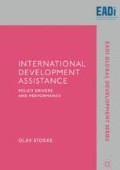Abstract
The chapter provides a description and analysis of the follow-up on the 0.7% target by individual DAC members, decade by decade and into the new century. The major Western countries remained the main providers of ODA in absolute terms (measured in US dollars), but their share of the DAC total declined. This applies especially to the US, which provided more than half of the DAC total in the early years. Overall, the ODA of DAC countries as a share of GNP/GNI declined over the years. Vis-à-vis the 0.7% target, the so-called frontrunners—Denmark, the Netherlands, Norway and Sweden—made a difference, although their ODA was modest in absolute terms. Their share of the DAC total increased from 2.5% in 1960 to 11.7% in 2016.
Access this chapter
Tax calculation will be finalised at checkout
Purchases are for personal use only
Notes
- 1.
Stokke (2009): Table A.1. This table, and the following tables from the same source (Tables A.3, A.7, A.10, and A. 13) referred to in this chapter, are based on DAC statistics in current prices and exchange rates (actual transfers). During the first four years of the 1960s, the US contributed 0.56%, 0.59%, 0.56% and 0.49% of its GNP in ODA, respectively, but this percentage declined to between 0.33% and 0.31% during the last three years of the decade. France contributed 14.5% of the total ODA of the DAC in current prices during this decade, but this assistance also included the assistance to its dependencies (Départements d’Outre-Mer [DOMs] and Territoires d’Outre Mer [TOMs]). In the first three years of the 1960s, France’s assistance amounted to 1.38%, 1.35% and 1.26% of its GNP, respectively, declining to 0.71%, 0.67% and 0.68%, respectively, during the last three years of the decade. In the 1960s, the UK provided 9.7% of the total ODA of the DAC. As a share of GNP, its ODA varied between 0.59% and 0.46% during the first seven years of the period and between 0.44% and 0.39% during the last three years of the 1960s.
- 2.
Stokke (2009): Table A.1.
- 3.
Ibid.
- 4.
Ibid.
- 5.
Ibid.
- 6.
Ibid. Please keep in mind that throughout this chapter—based on OECD statistics—ODA (and percentages of GNP/GNI) are based on actual transfers. Targets set by the frontrunners may, in contrast, be budgetary targets—that is, targets set in the currency of the countries concerned, calculated one year in advance and based on the assumed growth of the GNP—not the actual transfers.
- 7.
Ibid: Tables A.3 and A.6. For a few Arab countries, the golden era as aid providers continued into the 1980s. This applied especially to Saudi Arabia and Kuwait, but then with a declining trend towards the end of the decade. As a share of GNP, Saudi Arabia’ development assistance was well over 1% during the first part of the 1980s (OECD 1987: 78).
- 8.
Stokke (2009): Table A.7.
- 9.
The US’ share of the total ODA of DAC countries for the 1980s was 24.7%—down from 57.7% in the 1960s and 27.5% in the 1970s. France’s share was 14.7%, about the same percentage as in previous decades (14.5% in the 1960s and 14.7% in the1970s). The share of the UK was 5.7%, down from 9.7% in the 1960s and 7.2% in the 1970s (Stokke 2009: Tables A.1, A.3, and A.7).
- 10.
Stokke (2009): Table A.7.
- 11.
Ibid.
- 12.
Ibid.
- 13.
In the 1990s, OECD statistics started to report based on GNI—but not systematically.
- 14.
Stokke (2009): Tables A.7; A.10. For 1999, GNI is substituted for GNP.
- 15.
Stokke (2009): Table A.10. In 1996 and 1997, the percentages were 0.12% and 0.09%, respectively. Its ODA increased from USD84 billion in the 1980s to USD96 billion in the 1990s.
- 16.
Ibid.
- 17.
Ibid.
- 18.
Ibid.
- 19.
- 20.
Ibid.—and calculations based on data in these sources.
- 21.
Ibid.
- 22.
Ibid.
- 23.
Ibid.
- 24.
- 25.
- 26.
Ibid.
- 27.
References
OECD. (1987). Development Co-operation. Efforts and Policies of the Members of the Development Assistance Committee. 1986 Report. Paris: OECD.
OECD. (2009). OECD Journal on Development. Development Co-operation Report 2009 (Vol. 10, No. 1). Paris: OECD DAC.
OECD. (2011). Development Co-operation Report 2011 (50th Anniversary ed.). Paris: OECD.
OECD. (2012). Development Co-operation Report 2012, Linking Sustainability and Development. Paris: OECD.
OECD. (2015). Development Co-operation Report 2015: Making Partnership Effective Coalitions for Action. Paris: OECD Publishing.
OECD. (2017). Development Co-operation Report. Retrieved from https://doi.org/10.17871/dcr-207-en
Stokke, O. (2009). The UN and Development: From Aid to Cooperation. Bloomington and Indianapolis: Indiana University Press.
Author information
Authors and Affiliations
Corresponding author
Rights and permissions
Copyright information
© 2019 The Author(s)
About this chapter
Cite this chapter
Stokke, O. (2019). The Follow-Up on the 0.7% Target: A Bird’s-Eye Perspective. In: International Development Assistance. EADI Global Development Series. Palgrave Macmillan, Cham. https://doi.org/10.1007/978-3-030-06219-4_3
Download citation
DOI: https://doi.org/10.1007/978-3-030-06219-4_3
Published:
Publisher Name: Palgrave Macmillan, Cham
Print ISBN: 978-3-030-06218-7
Online ISBN: 978-3-030-06219-4
eBook Packages: Political Science and International StudiesPolitical Science and International Studies (R0)

